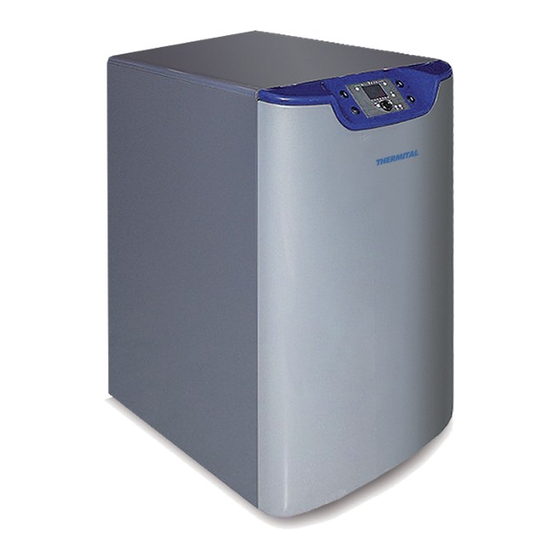
Table of Contents
Advertisement
Quick Links
Advertisement
Table of Contents

Summary of Contents for thermital THC V E OIL BLU
- Page 1 INSTRUCTION FOR THE USER THC V E OIL BLU...
-
Page 2: Table Of Contents
CONTENTS General safety information Precautions Control panel Mode selection User levels Start-up Temporary shutdown Preparing for extended periods of disuse Cleaning Maintenance Useful information The following symbols are used in this manual: = Identifies actions that require caution and ade- quate preparation. - Page 3 Dear Customer, Thank you for choosing THC V E OIL BLU boiler. You have purchased a modern, quality product that is designed to give dependable and safe service and to provide comfort for many years to come. Arrange for your boiler to be serviced regularly by THERMITAL's Technical Assistance Service.
-
Page 4: General Safety Information
The boiler must only be used for the purpose spec- ified by THERMITAL and for which it is designed. pleted to the highest standards in compliance with the instructions provided by... -
Page 5: Control Panel
CONTROL PANEL PRIMARY USER INTERFACE / CONTROLS bottom view 1 - Safety thermostat trip indicator. 2 - Electronic operator unit (controller). 3 - DHW production on/off button (only present if the optional remote storage cylinder is installed). A line appears under the "... - Page 6 SECONDARY USER INFORMATION / DISPLAY A - DHW mode: ON or OFF B - Central heating modes: AUTOMATIC CONTINUOUS COMFORT Continuous REDUCED COOLING Frost protection. The "t" symbol is displayed. C - Small numeric display: time D - Message area E - Daily heating program indicator F - Large numeric display: current value G - Display symbols:...
- Page 7 H1 - Burner running Notes on functioning The control panel on the THC V E OIL BLU boiler controls the following functions. - Frost protection: The pumps are switched on on the - Limit thermostat (parameter 2310): This function shuts...
-
Page 8: Mode Selection
MOdE SELECTION Press the central heating mode button (5) to select the various modes. The active mode is shown by a line under the corresponding symbol. Boiler temperature Automatic In automatic mode, room temperature is controlled by the time program. Characteristics: - Central heating operates according to the time program. - Page 9 Information Press the information button (6) to display: - Errors or maintenance codes (see the “Errors/Maintenance codes” section) - Special messages. Other screens: Other screens depend on the system configuration and status. Some of the info lines shown below may not therefore appear.
-
Page 10: User Levels
(User, Commissioning, etc.). Parameter values on the Commissioning, Heating engineer and OEM levels must only be changed by the THERMITAL Technical Assistance Service. Time of day and date Operator unit EXAMPLE: SETTING THE CURRENT TIME - From the main screen press "OK". - Page 11 Ora e data - The message area shows the current hour. Press "OK". Ore / minuti Time of day and date Hours/minutes - The display flashes the current hour. Turn the knob to go on or back to the correct value. Press "OK"...
-
Page 12: Start-Up
START-UP Have THERMITAL’s Technical Assistance Service start-up your boiler for the first time. Once this has been done, the boiler can be left to function automatically. Under certain circumstances, such as after long periods of disuse, the user may need to re-start it without involving the Technical Assistance Service. Before doing so, perform the following checks... - Page 13 Setting the room temperature setpoint Turn the knob (14) to set the desired room temperature comfort setpoint. Proceed in a similar way to set the room temperature reduced setpoint. - Press the "OK" button (13). Comfort setpoint - Select “Heating circuit 1”. - Set the room temperature reduced setpoint.
- Page 14 °C Outside temperature Heating curve slope must only be set by the THERMITAL Technical Assistance Service. If no room units are installed, the room temperature setpoint set on the control panel simply performs a par- allel shift of the heating curves.
-
Page 15: Temporary Shutdown
TEMPORARY SHUTdOwN If you are going to be away for a short period of time like a weekend or a short holiday, etc. proceed as follows. - Press the central heating mode button (5) to select "Protection" mode (b). Power to the boiler remains switched on, and the dis- Boiler temperature play remains active. -
Page 16: Cleaning
THAT PROFESSIONALLY QUALIFIED PERSONNEL UNDERTAKE PERIODIC MAINTENANCE COMBUSTION EFFICIENCY MEASUREMENTS. THERMITAL’s Technical Assistance Service is qualified to satisfy these legal requirements and can also provide useful information on MAINTENANCE PROGRAMMES designed to guarantee: - greater safety - compliance with applicable legislation - freedom from the risk of fines in the event of spot checks. -
Page 17: Useful Information
USEFUL INFORMATION xxxxxxxx Seller: Installer: ....................................................................................................................Address Address ......................................................Tel. Tel............................................................Technical Assistance Service: ............................................Address ............................Tel............................... Date Work done Fuel oil supplier: ....................................................Address ............................Tel............................... Date Quantity supplied Date Quantity supplied Date... - Page 18 USER ENGLISH...
- Page 19 USER ENGLISH...
- Page 20 Via Mussa, 20 Z.I. - 35017 Piombino Dese (PD) - Italia Tel. 049.9323911 - Fax 049.9323972 - www.thermital.it - email: info@thermital.it As part of the company’s ongoing commitment to perfecting its range of products, the appearance, dimensions, technical data, equipment and accessories...











Need help?
Do you have a question about the THC V E OIL BLU and is the answer not in the manual?
Questions and answers